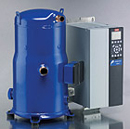
Manufacturers have been extending their lines of scroll compressors to include such approaches as variable speed.
When talking about all of the rapid changes going on with compressor technology, it might be appropriate to use a bit of NASCAR terminology. Reciprocating compressors are still in the lead, rotaries are holding onto second place, but scrolls are in third and starting to make their move. Screw compressors are still in the race sitting in fourth, and centrifugals are trailing in fifth.
Then, of course, NASCAR gets into a lot of talk about equipment modifications such as rear spoilers and the Car of Tomorrow. Compressor folks have their own versions of such talk, as with variable speed and energy efficiencies.
For the past several months,The NEWShas been gathering information from several sources on trends regarding compressors from both U.S. and worldwide perspectives. Manufacturer-specific advances announced at the most recent Air Conditioning, Heating, Refrigerating Exposition (AHR Expo) are included in the feature article “Jockeying For Position” in this issue ofThe NEWS, and there are a couple of application stories. Here we look at compressor trends in the broadest sense.
In information released at the AHR Expo, it was reported that:
• Reciprocating compressors worldwide held about a $7.27 billion market in 2006 (the latest year for which statistics were supplied) and made up almost one-half the market share.
• The rotary market was said to be about $4.04 billion, making up the majority of air conditioning compressors, especially in smaller sizes.
• Scrolls were said to be about a $2.71 billion market, with solid growth rates including a doubling of production levels 1996-2006.
• Screw compressors made up a $750 million market, with recent growth seen in their replacing semihermetic recips and small centrifugals in some chiller applications.
• Centrifugals were reported to be a $150 million market, primarily for large-capacity chillers.

Digital scrolls running on R-410A are becoming more and more common.
RECIPS AND ROTARIES
Historically, recips have been competitive with rotary compressors; screws and scrolls are in small-capacity applications, and screw compressors are in the large-capacity end. Now, reports said recips are facing increasing competition from rotary, scroll, and screw technologies, and this is especially related to efficiency issues.Some of the technologies being used by recips include high-efficiency compressors using R-600a, -134a, and -744 as refrigerants; vertical space-saving connections; digital variable approaches; and hermetic and semihermetic types.
Rotary compressors were reported to make up the majority of production and sales of air conditioning compressors, especially for small applications with dehumidifiers. According to one report, in 2006 China produced about 50 million rotary units, more than 50 percent of the 90.5 million worldwide production. Growth in this sector is driven by the growth of the light commercial market for RAC units.
The refrigerant trend in this market is R-410A. Almost all such rotaries produced in Japan now use that refrigerant, according to published reports.
Manufacturing of rotaries continues to tail off in North America and Europe, instead moving more and more to China, India, and Brazil. Among configurations are single- and twin-rotary, dc inverter, ac inverter, and designs for R-407C, -410A, -134a, and -744. (That last refrigerant, more commonly known as CO2, is getting a boost with the announcement that Sanyo may soon be only producing CO2 rotaries as its compressor of choice.)

Scroll compressors have been introduced for chiller applications.
SCROLLS AND SCREWS
No technology has been drawing more attention in recent years than scrolls. Almost all major manufacturers have been extending their production lines of scrolls to include a broader range of applications, including air conditioning and refrigeration applications as well as hp ranges. For example, large scroll compressors are starting to move into the market once dominated by small screw compressors. In one instance, dual scroll compressors (up to 60 hp in single and 120 hp in tandem) have been introduced for chillers, rooftops, and custom-engineered systems.Digital scrolls running on R-410A are becoming more common. A technological innovation has been the use of vapor injection to extend the operating range into the lower evaporating temperature range. In smaller sizes, scrolls are found in the 1- to 1.5-hp range, including dc inverter compressors using R-410A. Overall, noninverter technology dominates the market.
The U.S. accounts for more than 40 percent of world production of scrolls, followed by Japan.
In the screw compressor sector, applications include medium- and large-scale air conditioners such as water chillers and air-source heat pump chillers. Reports said they have become more common than semihermetic recips and small centrifugals in chiller applications. The dominant range is 60-150 hp in semihermetic configurations. Major producing countries are the United States, China, Japan, and Germany. The market size is estimated at about 130,000 units.
Tri-rotor screw compressors were first introduced at the end of 2005. The sector has begun shifting away from R-22 as the primary refrigerant and is turning to R-134a and -407C, as well as R-717 and -744. In general, screw compressors are classified as twin-screw and single-screw types.
Technologies include a falling film evaporator that can improve heat transfer coefficients and decrease refrigerant charges; capacity modulation, open drives for ammonia; variable-speed screws with a special oil management system; and single-screw compressors for refrigeration.
CENTRIFUGALS
Techs working with compressors know that recips and screws have positive-displacement systems. Centrifugals, by contrast, compress low-pressure refrigerant by centrifugal force caused by the impeller rotary.In 2006, the centrifugal compressor market was said to be close to 9,000. One of the most interesting innovations in this sector is an oil-free magnetic bearing compressor used in smaller chillers.
Publication date:03/31/2008




